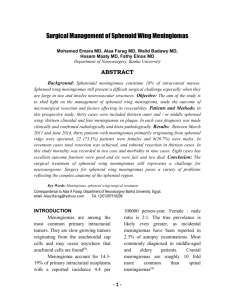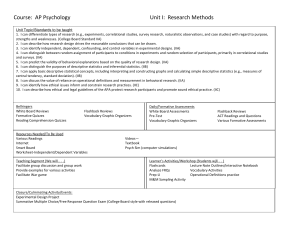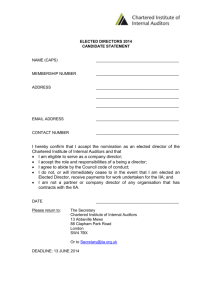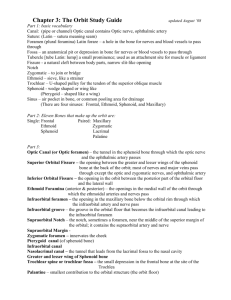Document
advertisement
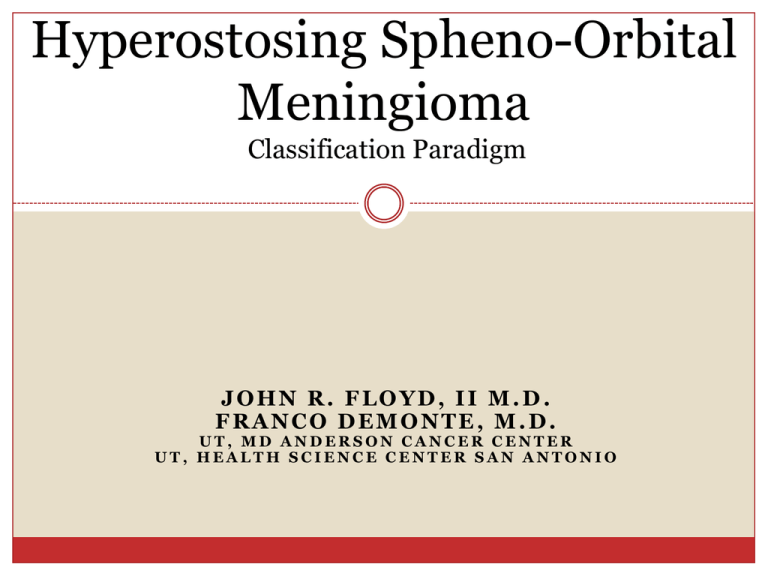
Hyperostosing Spheno-Orbital Meningioma Classification Paradigm JOHN R. FLOYD, II M.D. FRANCO DEMONTE, M.D. UT, MD ANDERSON CANCER CENTER UT, HEALTH SCIENCE CENTER SAN ANTONIO Cushing, H. and L. Eisenhardt, Meningiomas. Their classificaion, regional behavior, life history, and surgical end results. 1938, Springfield, IL: Charles C. Thomas. en plaque meningiomas with carpet like growth patterns, osseous invasion, and hyperostosis. global meningiomas grow into the Sylvian fissure, and its diameter is typically greater than the base. Incidence Castellano (1952) reviewed 608 cases of meningiomas 111 (18.4%) were along the sphenoid ridge 15 (2.5%) were associated with hyperostosis Incidence varies from 4-9% in case series Castellano, F., B. Guidetti, and H. Olivecrona, Pterional meningiomas en plaque. J Neurosurg, 1952. 9(2): p. 188-96 1950’s….conservative “It is true that vision on the affected side may be severely impaired or entirely lost….Nevertheless….this hardly seems to be sufficient reason to run the risk of a 10-15% mortality” “ The bone must be burred away, which is a rather dangerous procedure, as the fraise (burr) might slip. In one of our cases, this happened and the carotid artery was torn completely off at its point of entrance into the cranial chamber. This patient died two days later from the effects of cerebral ischaemia. Castellano, F., B. Guidetti, and H. Olivecrona, Pterional meningiomas en plaque. J Neurosurg, 1952. 9(2): p. 188-96. Bonnal, J., et al., Invading meningiomas of the sphenoid ridge. J Neurosurg, 1980. 53(5): p. 587-99. Group Type Location Extension A en masse Clinoid, Upward or Cavernous Medial Sinus, Medial Sphenoid wing B en plaque Greater and Downward Lesser Sphenoid Wings C en masse Combines feature of each Roser, F., et al., Sphenoid wing meningiomas with osseous involvement. Surg Neurol, 2005. 64(1): p. 37-43; discussion 43. Group I II III IV V Location Medial Sphenoid Wing Medial Sphenoid Wing Middle Sphenoid Wing Lateral Sphenoid Wing Extension None Cavernous Sinus None None En plaque None VI En Plaque Cavernous Sinus VII Pure Intraosseous None Confusing Nomenclature 1. 2. 3. 4. 5. 6. 7. 8. 9. 10. 11. En masse En plaque Sphenoid ridge meningiomas Pterional tumors en plaque Hyperostosing lesions of the ala magna Invading meningiomas of the sphenoid wing Spheno-cavernous meningiomas Intraosseous meningiomas Osteomeningioma Extradural meningiomas Spheno-Orbital Meningiomas Author Yr Patients Mortality Perm Morbidity Temp Morbidity Recurrence 1 Castellano, F 1952 15 3 (23%) 2 Columella, F 1974 3 0 (0) 0 (0) 0 (0) NS 3 Bonnal, J 1980 21 4 (19%) 12 (41%) --- 3 (10%) 4 Dolenc, V 1979 10 2 (20%) 2 (20%) 5 Pompili, A 1982 49 2 (4 %) 1 (2%) 13 (27%) 6 McDermott, M 1990 8 0(0) 2 ( 25%) 8 (100%) 7 Gaillard, S 1995 21 1 (5%) --- 9 (43%) 3 (14%) 8 Carrizo, A 1998 48 2 (4%) 7 (15%) 11 (23%) 8 (17%) 9 De Jesus, O 2001 6 NS NS NS 2 (33%) 10 Honeybul, S 2001 15 0 (0) 4 (27%) 11 (73%) 2 (13%) 11 Roser, F1 2005 82 1 (1.4 %) 7 (9%) 11 (13%) 25 (30%) 12 Sandalcioglu, E 2005 16 0(0) 2 (13%) 12 (80%) 9 ( 60%) 13 Schick, U 2006 67 0 (0) 9 (13%) 14 (21%) 7 ( 10%) 14 Ringel, F 2007 63 2 (3.2%) 21 (33%) 23 (37%) 16 (25%) 15 Al_Mefty, O 2007 17 0 (0) 0 (0) 4 (24%) Rationale 1. Multiple classification schemes. 2. Confusing nomenclature. 3. Currently, there are no Preoperative Classification schemes Purpose of the Preoperative Scale allows the surgeon to carefully evaluate the surgical condition, to determine risk factors for and against a procedure, to anticipate outcomes and problems in the postoperative period, to educate patients Proposed Classification Scheme 1. 2. 3. Osseous invasion Soft tissue invasion Presence of cranial nerve neuropathy Osseous Invasion Sphenoid Bone: Posterior Superior View Osseous Score Anterolateral greater sphenoid wing Lesser sphenoid wing Lateral orbital wall Orbital roof Lateral or superior orbital rim Temporal squamousal bone Temporal mandibular joint Inferomedial greater sphenoid wing •medial to basal foramina Anterior clinoid process/optic canal Body of sphenoid bone 1 2 3 Osseous Invasion Anteriolateral and inferiomedial greater wing of sphenoid affected; body of sphenoid, lesser wing, and anterior clinoid are not involved. Soft Tissue Invasion Soft Tissue Score Temporalis muscle / fossa Infratemporal fossa Temporal convexity dura globoid intradural component Intraorbital extraperiorbital Periorbital membrane Intraperiorbital extraconal 1 Dura of lateral cavernous sinus Dura of the superior orbital fissure Intraperiorbital intraconal extraapical Optic canal 2 cavernous sinus Intraperiorbital, intraconal, orbital apex Superior orbital fissure 3 Soft Tissue Invasion Lateral temporal dura and small intradural component. Soft Tissue Invasion Lateral cavernous sinus, superior orbital fissure, orbital apex Cranial Nerve Neuropathy Optic Neuropathy None Mild Optic Neuropathy Relative afferent papillary defect Decreased color vision Acuity better or equal to 20/400 Mild optic nerve pallor Visual field deficit Moderate Optic Neuropathy Acuity worse that 20/400 Optic nerve atrophy Severe Optic Neuropathy Light perception only Cranial III, IV or VI palsy Absent Present 0 1 2 3 A B Proposed Scale for Hyperostosing Spheno-Orbital Meningiomas (HSOMs) Score Grade 2-3 I 4-6 II 7-9 III Patients were identified from the Demographics Patients Male Female Ages Mean Age Mean Follow-up Previous Surgery Perioperative Deaths Deaths During Follow-up Recurrences Mean time to recurrence 20 4 (20%) 16 (80%) 31-83 (yrs) 54 (yrs) 41 (mos) 5 (25%) 0 2 (10%) 5 (25%) 32 (mos) Departmental database from February 1994 until April 2008. All meningiomas of the sphenoid ridge, cavernous sinus, and orbit were included if there was associated hyperostosis. Presenting Symptoms Presenting Signs & Symptoms N=20 % Proptosis 18 90% Vision loss 12 60% Diplopia 9 45% Temporal Swelling 4 20% Aphasia 3 18% CN Palsy 4 20% Methods Patients had formal ophthalmological evaluations pre and postop. Patients had detailed neuroimaging including CT scan, MRI brain =/- Gad with orbital fat sat sequences. Bicoronal incision, extradural approach was utilized, with orbital and zygomatic osteotomies as needed. Preoperative Score Preoperative Criteria and Accumulated Score Patient # Bone Score Soft Tissue Score 3 15 16 20 1 2 5 6 8 9 10 11 13 14 17 4 7 18 12 19 2 2 2 1 2 3 2 2 2 2 2 2 1 2 1 1 1 1 1 1 1 1 2 2 3 3 1 3 3 3 3 3 2 3 2 1 3 3 3 3 Cranial n. III, IV, VI Score Total Score Pre- operative Grade 1 1 1 A A A A A A A A A A A A A A A A B 3 3 3 2 4 5 4 5 6 4 6 6 6 5 5 4 5 IA IA IA IA IIA IIA IIA IIA IIA IIA IIA IIA IIA IIA IIA IIA IIB 1 3 3 B B B 6 7 9 IIB IIIB IIIB Optic neuropathy 1 1 1 1 1 2 Outcomes Evaluated 1. Clinical Outcomes a. Proptosis b. Vision c. Diplopia 2. Technical Outcomes a. Extent of Resection ( Simpson Grade) 3. Oncologic Outcome a. Time to Progression Clinical Outcomes: Proptosis Symptom Preop Proptosis 1. 2. 3. 4. 5. 6. 7. Postop Improved Worsened New Morbidity 18 15 (83%) 0 0 233* 185 (79%) 0 5 (2%) (enopthalmus) Roser, F., et al., Sphenoid wing meningiomas with osseous involvement. Surg Neurol, 2005. 64(1): p. 37-43; discussion 43. Shrivastava, R.K., et al., Sphenoorbital meningiomas: surgical limitations and lessons learned in their longterm management. J Neurosurg, 2005. 103(3): p. 491-7. Bikmaz, K., R. Mrak, and O. Al-Mefty, Management of bone-invasive, hyperostotic sphenoid wing meningiomas. J Neurosurg, 2007. 107(5): p. 905-12. Honeybul, S., et al., Sphenoid wing meningioma en plaque: a clinical review. Acta Neurochir (Wien), 2001. 143(8): p. 749-57; discussion 758. Ringel, F., C. Cedzich, and J. Schramm, Microsurgical technique and results of a series of 63 spheno-orbital meningiomas. Neurosurgery, 2007. 60(4 Suppl 2): p. 214-21; discussion 221-2. Sandalcioglu, I.E., et al., Spheno-orbital meningiomas: interdisciplinary surgical approach, resectability and long-term results. J Craniomaxillofac Surg, 2005. 33(4): p. 260-6. Schick, U., et al., Management of meningiomas en plaque of the sphenoid wing. J Neurosurg, 2006. 104(2): p. 208-14. Proptosis No statistical trend across preoperative grades, eg, Grade IA vs Grade IIIB. The bone score as an independent variable did not predict the Simpson Grade of resection or recurrence/progression. Clinical Outcomes: Vision Symptom Preop Vision Improved Worsened New Morbidity 12 4 (42%) 0 0 133* 58 (43%) 3 (2%) 1 (< 1%) Optic Neuropathy Preoperative Postop Postoperative Improvement # Patients APD 12 CD 6 ECF 4 *< or = 20/400 4 LPO 2 APD 0 CD ECF *< or + 20/400 LP O 1 2 3 0 APD =Afferent Pupillary Defect; CD = Color Desaturation; ECF = Enlarged Central Field; * Acuity; LPO = Light Perception Only Clinical Outcomes: Vision Positive trend toward absence of Optic Neuropathy (ON) and Simpson Grade I resection and Preoperative Grade IA. (not statistically significant). Positive trend (p=0.074) toward the presence of ON and Simpson Grade IV resection (not statistically significant). Presence of Optice Neuropathy as an independent variable did not predict the Simpson Grade of resection or progression or recurrence Clinical Outcomes: Diplopia 4/9 (44%) patients diplopia resolved Double vision caused from rectus muscle constriction. Orbital decompression relieved symptoms. • 5/9 (55%) patients had unchanged diplopia 4 were due to true CN III, IV or VI palsy 1 pt had previous TBI • 1 patient developed delayed double vision due to lateral rectus fibosis Diplopia • Positive trend for the absence of CN palsy in the preoperative Grade IA HSOMs (not statistically significant). • The presence of cranial nerve palsy did not independently predict the Simpson Grade of resection, progression or recurrence. Clinical Outcomes Clinical Outcome: Improved (I); Stable (S), Worse (W) Summary of Clinical Outcomes Grade IA IIA IIB IIIB Patient # Proptosis 3 15 16 20 1 2 5 6 8 9 10 11 13 14 17 4 7 18 12 19 I I I I ON Diplopia I I I I I I I I I I I S I I S S S I S I S I I S I S S S S I S W S S S Technical and Oncological Outcomes Preoperative Grade HSOM IA IIA IIB IIIB Technical Outcome Oncologic Outcome Patient # Simpson Grade (extent of resection) Time to Progression (Months) 3 15 16 20 1 2 5 6 8 9 10 11 13 14 17 4 7 18 12 19 I I I I I I I IV IV IV IV IV IV IV IV I IV IV II IV 9 96 24 18 12 12 Technical and Oncological Outcomes Series Yr Followup average (mos) # Pts Recurrenc Time to Average e (%) Recurrence Time to (mos) Recurrence (mos) Honeybul, S 2001 40 15 2 (13%) 36,96 66 Roser, F 2005 66 82 25 (30%) Not specified 32 Sandalcioglu, E 2005 68 16 9 ( 60%) 16,118,13,66,4 7,62,9,12, 17 40 Shrivastava, R 2005 60 25 2 (8%) 12, 132 73 Schick, U 2006 46 67 7 ( 10%) 29,21,47,21,14, 23,13 24 Ringel, F 2007 54 63 16 (25%) Not Specified Not Specified Bikmaz, K. 2007 36 17 1 (6%) 72 72 DeMonte 2009 42 20 5 (25%) 96,24,18,12,9 32 Technical and Oncological Outcomes Positive trend toward HSOM Grade IA and Simpson Grade I with no recurrences (not statistically significant). The individual bone score, presence or degree of optic neuropathy, presence or absence of cranial nerve palsy did not predict Simpson Grade resection, progression, or recurrence Soft tissue score was highly predictive of Simpson Grade resection ( p<0.001) When grouping soft tissue score 1 +2 vs. 3, this did predict tumor progression. ( p <0.045) When analyzed as a continuous variable, the hazard score for the total score ( eg 2-9; not by Grade), is 3.7, 95% CI 0.95 – 14.4, with a p value close to significance p = 0.06 Oncologic Outcomes Areas of progression: cavernous sinus (two), orbital apex and cavernous sinus (two), and intraorbital (one). All patients have had tumor stabilization with either: SRS IMRT Other Variables No statistical difference between preoperative score or grade and: Gender Histological MIB grade rate Progression was unrelated to MIB rate or histology Positive trend between higher preoperative grade and increasing age (not statistically significant). Overall, proptosis will improve 80% Conclusions Limitations Limited number of patients Short followup for certain patients of time Vision will improve about 40% of time ( no improvement if LPO) Cranial nerve III,IV, or VI palsy tend not to improve The strongest correlation with predicting outcomes is the soft tissue score: Extent of resection ( Simpson Grade) Risk for Progression Progression occurs from residual tumor in the cavernous sinus, superior orbital fissure, orbital apex Trends Conclusions Grade IA: Improved Clinical Symptoms Complete Resections No recurrences Grade IIA: Improved or Stabilized Clinical Symptoms Incomplete Resections More likely to have recurrence/progression Grade IIB or IIIB Stabilized Clinical Symptoms Incomplete Resections More likely to have recurrence/progression Summary The approach to HSOMs has shifted from a nonsurgical stance, to a present day patient outcome oriented strategy.
